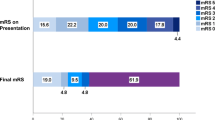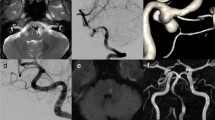Abstract
Introduction
The course of the vertebral artery after exiting from the C1 foramen transversarium and prior to entering the dura lends itself to compression in C1–2 instability. However, atlantoaxial dislocation presenting with vertebrobasilar insufficiency and posterior circulation stroke (PCS) is rare.
Methods
In this retrospective study, we identified 96 patients with PCS who had complete radiological data. Ten (10.4%) patients had craniovertebral junction (CVJ) anomalies, of which six underwent surgery and four were managed conservatively. The clinical and functional outcomes were measured in the two groups.
Results
Left-sided strokes were seen in 7/10 patients, the majority of whom had left dominant vertebral arteries. The mean age at presentation in those with CVJ anomalies was 27.2 ± 12.8 years that was significantly lower than those without CVJ anomalies, 52.2 ± 14.5 years (p ≤ 0.001). The etiologies of PCS in those < 50 years were CVJ anomalies (30%), atherosclerosis (30%) and vasculitis (27%); however, the overwhelming majority of strokes in the > 50 year age group was atherosclerosis (91%). Postoperatively, there were no recurrent strokes in the operated patients, who also obtained significant clinical improvement on the modified Rankin Scale, Nurick Scale and modified McCormick Scale as compared to those who did not undergo surgery.
Conclusion
Early diagnosis and surgical treatment of CVJ instability prevent recurrent strokes and improve outcomes in patients with PCS. Physicians and spine surgeons need to be sensitized regarding CVJ anomalies as a cause of PCS enabling early diagnosis with dynamic imaging particularly in the younger age group.
Graphic abstract
These slides can be retrieved under Electronic Supplementary Material.





Similar content being viewed by others
References
Sorensen BF (1978) Bow hunter’s stroke. Neurosurgery 2:259–261
Cacciola F, Phalke U, Goel A (2004) Vertebral artery in relationship to C1–C2 vertebrae: an anatomical study. Neurol India 52:178–184
Kulkarni GB, Mustare V, Pruthi N, Pendharkar H, Modi S, Kulkarni A (2014) Profile of patients with craniovertebral junction anomalies with posterior circulation strokes. J Stroke Cerebrovasc Dis 23:2819–2826
Matsuyama T, Morimoto T, Sakaki T (1997) Comparison of C1–2 posterior fusion and decompression of the vertebral artery in the treatment of bow hunter’s stroke. J Neurosurg 86(4):619–623
Desouza RM, Crocker MJ, Haliasos N, Rennie A, Saxena A (2011) Blunt traumatic vertebral artery injury: a clinical review. Eur Spine J 20(9):1405–1416
Nandish HS, Borkar SA, Klar SS, Sharma BS, Mahapatra AK (2015) Pediatric posterior cerebral artery stroke as a presentation of atlantoaxial dislocation. J Pediatr Neurosci 10(2):149–152
Sawlani V, Behari S, Salunke P, Jain VK, Phadke RV (2006) “Stretched loop sign” of the vertebral artery: a predictor of vertebrobasilar insufficiency in atlantoaxial dislocation. Surg Neurol 66(3):298–304
Agrawal D, Gowda NK, Bal CS, Kale SS, Mahapatra AK (2006) Have cranio-vertebral junction anomalies been overlooked as a cause of vertebro-basilar insufficiency? Spine 31(7):846–850
Powers B, Miller MD, Kramer RS, Martinez S, Gehweiler JA Jr (1979) Traumatic anterior atlanto-occipital dislocation. Neurosurgery 4(1):12–17
Sardhara J, Behari S, Sindgikar P, Srivastava AK, Mehrotra A, Das KK, Bhaisora KS, Sahu RN, Jaiswal AK (2017) Evaluating atlantoaxial dislocation based on Cartesian coordinates: proposing a new definition and its impact on assessment of congenital torticollis. Neurosurgery 82(4):525–540
Bhatia R, Desouza RM, Bull J, Casey ATH (2013) Rigid occipitocervical fixation: indications, outcomes, and complications in the modern era. J Neurosurg Spine 18(4):333–339
Wilson JL, Hareendran A, Grant M, Baird T, Schulz UG, Muir KW, Bone I (2002) Improving the assessment of outcomes in stroke: use of a structured interview to assign grades on the modified Rankin scale. Stroke 33(9):2243–2246
Ferguson L, Scheman J (2009) Patient global impression of change scores within the context of a chronic pain rehabilitation program. J Pain 10:73
Revanappa KK, Rajshekhar V (2011) Comparison of Nurick grading system and modified Japanese Orthopaedic Association scoring system in evaluation of patients with cervical spondylotic myelopathy. Eur Spine J 20(9):1545–1551
Manzano G, Green BA, Vanni S, Levi AD (2008) Contemporary management of adult intramedullary spinal tumors-pathology and neurological outcomes related to surgical resection. Spinal cord 46:540–546
Vernon H, Mior S (1991) The neck disability index: a study of reliability and validity. J Manip Physiol Ther 14:409–415
Wadia NH, Bhatt MH, Desai MM (1990) Myelopathy of congenital atlantoaxial dislocation. In: Chopra JS (ed) Advances in Neurology. Elsevier Science Publishers, B.V. (Biomedical division), Amsterdam, pp 455–464
MacKenzie JM, Rankin R (2003) Sudden death due to atlantoaxial subluxation in Marfan syndrome. Am J Forensic Med Pathol 24:369–370
Panda S, Ravishankar S, Nagaraja D (2010) Bilateral vertebral artery dissection caused by atlantoaxial dislocation. J Assoc Physicians India 58:187–189
Ravensbergen J, Krijger JK, Hillen B, Hoogstraten HW (1996) The influence of the angle of confluence on the flow in a vertebro-basilar junction model. J Biomech 29:281–299
Park JH, Kim JM, Roh JK (2007) Hypoplastic vertebral artery: frequency and associations with ischaemic stroke territory. J Neurol Neurosurg Psychiatry 78:954–958
Sivaraju L, Mani S, Prabhu K, Daniel RT, Chacko AG (2017) Three-dimensional computed tomography angiographic study of the vertebral artery in patients with congenital craniovertebral junction anomalies. Eur Spine J 26:1028–1038
Haynes MJ, Cala LA, Melsom A, Mastaglia FL, Milne N, McGeachie K (2002) Vertebral arteries and cervical rotation: modelling and magnetic resonance angiography studies. J Manip Physiol Ther 25:370–383
Gulli G, Marquardt L, Rothwell PM, Markus HS (2013) Stroke risk after posterior circulation stroke/transient ischemic attack and its relationship to site of vertebrobasilar stenosis: pooled data analysis from prospective studies. Stroke 44:598–604
Singer WD, Haller JS, Wolpert SM (1975) Occlusive vertebrobasilar artery disease associated with cervical spine anomaly. Am J Dis Child 129:492–495
Author information
Authors and Affiliations
Contributions
AGC, SA and KP contributed to the conception and design. HV and EJG helped in drafting the article. SAM contributed to the interpretation of radiology. AGC was the guarantor.
Corresponding author
Ethics declarations
Conflict of interest
The authors declare that they have no conflict of interests.
Additional information
Publisher's Note
Springer Nature remains neutral with regard to jurisdictional claims in published maps and institutional affiliations.
Electronic supplementary material
Below is the link to the electronic supplementary material.
Rights and permissions
About this article
Cite this article
Vupputuri, H., Gandham, E.J., Mani, S.A. et al. Dynamic imaging of the craniovertebral junction is mandatory in patients with posterior circulation strokes. Eur Spine J 29, 1078–1086 (2020). https://doi.org/10.1007/s00586-020-06337-3
Received:
Revised:
Accepted:
Published:
Issue Date:
DOI: https://doi.org/10.1007/s00586-020-06337-3




